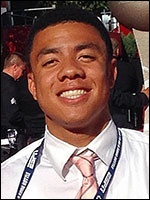2 KBIA-FM Stories Win Mastering the Method Multimedia Category
Reporting Teams Covered Missouri Sinkholes and Antler Hunting with Dogs
By Caroline Murray
Columbia, Mo. (April 8, 2015) — Five students have been named winners in the multimedia category of the Mastering the Method content for their two projects. Seniors George Varney, Gabriel Jefferson and Jasmine Bailey won for their reporting on Missouri sinkholes, and juniors Jason Boatright and Elizabeth Eisterhold won for their project on antler hunting with dogs.

The projects were chosen from a pool of entries from Missouri School of Journalism students. Both projects ran on KBIA.
The Mastering the Method contest, which launched in 2013, recognizes outstanding work by undergraduates in the areas of broadcast, multimedia, photography and writing.
Shedding Light on Antler Hunting with Dogs
Eisterhold said of her and Boatright’s entry:
I came from a very small town in Missouri where hunting for antlers was a special event for many community members. When I mentioned the sport to a college friend in casual conversation, my friend had not heard of it before but was interested in learning more about it. I realized though this is a sport loved by countless devoted hunters across the state, it is a hobby unknown to many people who have never stepped foot in the woods.
Once my partner Jason Boatright and I did more research, we realized dogs trained to hunt for antler sheds had become increasingly popular over the last 10 years. We knew this was an interesting spin on the original techniques of the sport, so we decided to find someone who shed hunted with a dog. Luckily, that person was Kyle Kennison.

Kennison and his dog Luke invited us to their family farm to tag along during a shed-hunting adventure and experience what a typical hunt was all about. Jason and I divided the multimedia elements based on our personal strengths. Jason recorded video while I captured photos and audio elements. One main goal we agreed on as a team was showcasing the dog’s role in this activity and the relationship between Kennison and Luke during these shed-hunting occasions. We accomplished our goal by attaching a GoPro to a dog harness and including the footage from the dog’s point of view in our project. We also attached a GoPro to Kennison’s hat to give our audience a different perspective they wouldn’t normally see when Luke found a shed and Kennison rewarded him with a treat. Both of these methods made it possible for us to capture the intimate moments between a dog and its owner that we wouldn’t have otherwise been able to capture.
Overall, this project forced us to think differently about future news story ideas and also how to execute them uniquely yet effectively for our audience by thinking beyond the techniques that we would normally use.

Missouri Sinkholes: What You Need to Know
Varney said of his team’s entry:
The story started when I came across sinkhole information on the Missouri Department of Natural Resources website. I had a lot of questions, and when I pitched this idea to the team, they did, too. So we set about answering them. I took the science side to the story (how do the sinkholes form and where), Gabriel Jefferson tackled the legal side and the history of sinkholes in the state, and Jasmine Bailey went out and interviewed homeowners with sinkholes on their property to get their perspective.
As multimedia reporters, we wanted to use the medium that would best tell particular parts of the story. After I interviewed a sinkhole expert about the natural forces that create sinkholes, I took a video camera into a nearby cave (Devils’s Icebox in Rock Bridge State Park) to get the visuals to match the expert’s explanation.

When I found the MDNR had mapped known sinkholes and had the data available for public download, I knew had to share this information in a Google Map so the average reader wouldn’t have to figure out how to download the shape-files and figure out the mapping themselves.
The goal of this project was to provide a factual resource for the community. We had social elements, like asking for input on social media, to make sure we were following leads people would be interested in.
The format as a more explanatory resource than a breaking news piece served us especially well when we found that for the most part, sinkholes aren’t currently a major concern in Columbia. But as construction continues north of town where the sinkholes are more prevalent, they could be. And when those questions come up this, resource will be available to answer questions before a tragedy happens.

Jefferson said of his contributions:
The reporting I did for part two of our sinkhole series was focused on the Boone County Storm Water Ordinance and how that affects residents and businesses in Boone County. One of my goals in particular was to set up an interview with someone who took part in the creation of the ordinance and could easily explain how it has changed things in the county and how it affects the people here.
I ended up doing an interview with Steve Shawver, the director of Boone County Resource Management. He helped develop the ordinance and is in charge of the Boone County Storm Water Department, which is directly related to sinkholes. I used that interview, along with the secondary research I did, to come up with a short piece that would be simple enough for our audience to understand what the ordinance is, when it happened, why it happened and how it affects them. Lastly, I implemented a timeline that would assist the article and give people a simple rundown of major events related to sinkholes in Boone County.
Updated: August 4, 2020